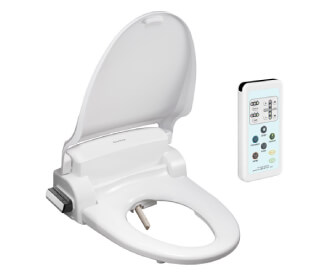Overview
Bidets are gradually becoming part of every bathroom in many countries. Some people may still don’t know what a bidet is, and a wild guess is often amusing. For the basics, a bidet is a bathroom fixture used for washing your lower body. Instead of consuming toilet paper, you can enjoy a gentle splash of water on your undercarriage for cleaning.
There are several types of bidets that you can install and use in your bathroom. However, in this article, we’ll focus on an innovation called bidet seats.
What’s a Bidet Seat?
A bidet seat is a variation of bidets that are getting popular nowadays. These are special variants where the nozzle sprays are placed inside and under the toilet seat. You can enjoy the perks of hands-free washing experience, which means that you can mind your own business without any hassle.
Bidet seats are the products of advanced technology. They’re more expensive compared to the other types, but the features and benefits are overwhelming.
Types of Bidet Seats
For starters, bidet seats come in two classifications. In a nutshell, you can choose between electric bidet seats and non-electric bidet seats.
This type of bidet seat offers the advanced, high-end variants in the market today. If you’re a tech-savvy, you’ll surely love all the advanced features and controls of electric bidet seats. Given that these are electric units, you have to connect the fixture to a power outlet.
Most common electric bidet seats have self-cleaning nozzles, heated seat, adjustable temperatures, and power-saving features. On top of that, more expensive units have deodorizer, multi-spray options, remote control function, and even a night light!
If you have what it takes to opt for units at the highest end of the cost range, expect to be amazed at features such as self-sterilizing bowl and nozzle, automatic seat function, and additional spray modes.
All in all, electric bidet seats are the epitome of a convenient toilet experience. They don’t simply aid you for washing, but they can also provide you with more perks that are enjoyable. You can take note that these units offer the highest level of customization for your personal needs. Electric bidet seats may cost an arm and a leg, but the payback is noteworthy.
Let’s admit that some people don’t want to keep things complicated. In general, bidets were originally created to help us with cleaning and washing our undercarriage. This is also the same with bidet seats.
If you prefer a simple, basic and easy-to-use fixture, you can opt for non-electric bidet seats. This type offers the basic features and functions such as self-cleaning nozzle, adjustable spray position and pressure, and even feminine wash on some models.
The catch is, unlike electric counterparts, they work through the water pressure in your home. This can be an advantage if you can’t afford the hassle of power failures, especially during a toilet emergency.
As long as the water supply is working, you can get a sigh of relief as you take delight in washing yourself. Take note that you should have a minimum water pressure of forty-five to fifty-five (45 – 55) PSI.
Non-electric bidet seats are simple to install, maintain and clean. They’re long-lasting too! Most importantly, this is your go-to option if you prefer a less expensive unit.
Choosing a Bidet Seat
Whether you opt for an electrical or non-electric bidet seat, you should never miss the rest of the most important buying factors.
Most bidet seats are made of several plastic grades. Some come as solid plastics, while some are treated. The former may be a viable option, but the latter prevents the build-up of tough stains, molds and unpleasant odor.
On the other hand, you can have a wooden bidet seat. Woods may either come in the form of laminated molded wood or treated solid wood. The former gives a shiny finish to the fixture, and the laminate adds durability to the overall structure, but it’s not the best option for humid bathrooms. The latter is resistant to moisture and fungi, plus it’s also hardwearing.
You may already know that all toilets come in different heights, but what matters more is the size of your toilet bowl.
Bidet toilet seats come in two shapes. You can choose between a round or elongated one. There’s no better than the other, as it boils down to your preference.
Round toilet bowls have a diameter of sixteen-and-a-half to seventeen-and-three-fourths inches (16 ½ -17 ¾ in.), while the elongated ones have a diameter of eighteen to nineteen-and-a-half inches (18 – 19 ½ in.).
This may not be a big deal for some, but if you want to keep your bathroom as an aesthetically pleasing part of your home, no worries! Most bidet seats are white, but you can also choose from black, grey or cream colors.
The installation process will depend on the type of bidet seat you are going to buy. Non-electric bidet seats are easier to install through your water supply. Sticking with cold water supply is the most common option, but if you also want warm water, you can get one through your sink or other fixture near your bidet seat.
Electric bidet seats need an electrical outlet close to them. If the power supply is not yet available in your bathroom, you need to install it first.
All in all, if you can install the bidet seat right away with proper tools, there’s nothing to worry about. However, if you don’t have the skills, let the licensed plumber do the job for you.
For some people, the final verdict depends on the cost of the fixture. Non-electric bidet seats cost $100 and below, while electric ones cost $200 or more. A higher cost guarantee you extra features for your convenience, but it’s not a factor of quality. If you’ve found satisfaction with a non-electric variant’s specifications and quality, it’s a great place to start.





